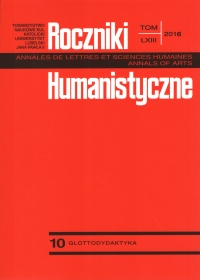Teaching culture at school through combining the elements of Content and Language Integrated Learning and the Theory of Multiple Intelligences
Abstract
Content and Language Integrated Learning (CLIL) has found its valuable place in the education of the multilingual and multicultural European community of the XXI century. According to Coyle (1999) the methodology of the CLIL approach is based on four key concepts, known as the conceptual framework. Culture, being one of them (together with content, communication and cognition), is given a due significance. Cultural elements in teaching, both the foreign languages and other non-linguistic subjects, are an indispensable part of modern education, as the world has become a “global village” and we all need to know far more than just the languages spoken by other nations. On the other hand, the Theory of Multiple Intelligences (Gardner, 1999) changed the way we perceive our intelligence and allowed to look at education from a new angle. Both these educational approaches serve as the theoretical foundations of the practical study presented in this paper.
Schools also had to undergo the shift to become places where pupils can gain not only the theoretical knowledge but also the social, cultural and pragmatic skills to become “the citizens of the world”. Bilingual Primary School Smart School in Zamość, Poland is one of the schools that based its ideology on this transition. Being the head-master of this school, and gaining from the experience attained during my ongoing PhD research in the field of CLIL in the Institute of English Studies of the Catholic University of Lublin, I will present my observations on how cultural elements may be successfully brought into the educational process, both during foreign language classes and throughout the entire school day.
The aim of this paper is to reveal the vital place of teaching culture and to equip the reader with a scope of genuine ideas on how to incorporate cultural elements into the school curricula by combining the methodologies of CLIL and MI Theory.
References
Chen J.Q., Moran S., Gardner H., 2009, Multiple Intelligences around the World, San Francisco: Jossey-Bass Publishers.
Coyle D., 1999, Theory and planning for effective classrooms: supporting students in content and language integrated learning contexts in Masih, J. (Ed): Learning Through a Foreign Language, London: CILT (Centre for Information on Language Teaching and Research).
Coyle D., 2008, CLIL – a pedagogical approach, in N. Van Deusen-Scholl, & N. Hornberger, Encyclopedia of Language and Education, 2nd edition (pp. 97-111), Springer.
Dakowska M., 2007, Teaching English as a Foreign Language, Warszawa: Wydawnictwo Naukowe PWN.
European Commission, 2006, Content and Language Integrated Learning (CLIL) at School in Europe, Brussels: Eurydice.
European Commission, 2012, Key Data on Teaching Languages at School in Europe Eurydice, Brussels: Eurydice.
Gardner H., 1993, Frames of Mind: The Theory of Multiple Intelligences, New York: Basic Books.
Gardner H., 1999, Intelligence Reframed: Multiple Intelligences for the 21st Century, New York: Basic Books.
Gardner H., et al., 2001, Inteligencja – wielorakie perspektywy, Warszawa: WSiP.
Gardner H., 2002, Inteligencje wielorakie. Teoria w praktyce, Poznań: Media Rodzina.
Gardner H., 2006, Multiple Intelligences: New horizons, New York: Basic Books.
Gardner H. 2006, The Development and Education of the Mind. The Selected Works of Howard Gardner, London: Routledge.
Marsh D., et al., 2002, CLIL/ EMILE. The European Dimension. Actions, Trends and Foresight Potential, Jyväskylä: University of Jyväskylä.
Mehisto P., Marsh D., Frigols M.J., 2008, Uncovering CLIL. Content and Language Integrated Learning in Bilingual and Multilingual Education, Oxford: Macmillan.
Zatorska M., Kopik A., 2012, Wielointeligentne Odkrywanie Świata – Program Edukacji Wczesnoszkolnej, Warszawa: Ośrodek Rozwoju Edukacji.
Copyright (c) 2016 Roczniki Humanistyczne

This work is licensed under a Creative Commons Attribution-NonCommercial-NoDerivatives 4.0 International License.





